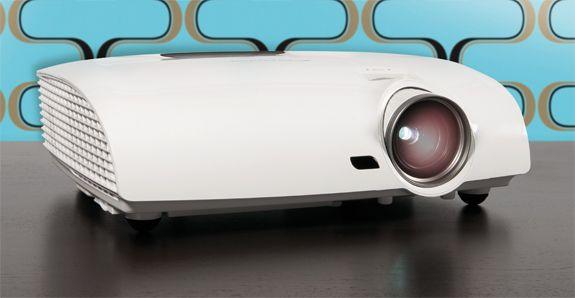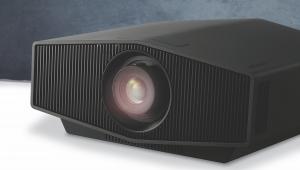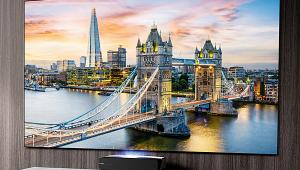Optoma HD33 review

Don’t be surprised if you’re told you’ll have to go on a waiting list to get an Optoma HD33. According to a little birdie in the trade, demand for this model is outstripping supply across Europe – and having now lived with one for a few weeks, I’m not surprised. Typically selling for less than £1,400, they represent ridiculously good value for bigscreen aficionados – particularly when you consider that a year ago you couldn’t get a Full HD 3D PJ for less than £3K.
Affordable the HD33 may be, but it still cuts a fine figure. The finish is high grade, with a white gloss cabinet that’s very a la mode. While there are on-body controls, you’ll not feel compelled to use them. The PJ ships with a sympathetically styled remote control, backlit by cool blue LEDs.
The HD33 is surprisingly compact: at just 122mm tall it’ll not obstruct anyone’s view when parked on a coffee table, and given that it weighs just 4.5kg, ceiling mounting is a very practical proposition.
Home cinema onlyUnlike its chief rival, the Epson EH-TW6000, this Optoma does not feature any in-built audio system. It’s a home theatre projector through and through, and expects to be partnered with a separate noise maker.
To that end, video connectivity can be considered more than adequate: there are two HDMI v1.4a inputs, plus component, PC and regular phono. To assist in more elaborate systems, there’s also an RS232 control port and 12V trigger, useful if you want to sync the HD33 to an electric screen (power up and the screen comes down, and vice versa).
Interestingly, Optoma’s entry-level 3D projector uses an RF rather than IR sync transmitter for its 3D glasses. This has the advantage that no line-of sight is required, and the little short-leash RF transmitter, which has to be plugged into the projector, can be secured wherever is convenient.
The general operating noise of the HD33 is low, but not whisper-quiet. Optoma rates it at 27dB. My advice is to keep the projector on its Standard lamp setting whenever possible. Select AI, which alters the light output to counter any ambient lighting, or Bright, and fan noise escalates. Single-chip DLP models like this often sound louder than their LCD rivals, because not only is the fan actively cooling the light engine, the spinning colour wheel adds its own unique pitch to the mix.
To put this into context, I didn’t find it intrusive at all when used with a full-throttle home cinema system, although in isolation I could clearly hear an uneven whir.
Plonk and playYou won’t need to reserve yourself a great deal of time to set up Optoma’s HD33. The provided manual focus and zoom wheel allow you to quickly frame the image, and there’s keystone correction to square things up if you’re not able to get accurately aligned. It’s always best to make minimal electronic corrections, not least because you’ll loose picture information at the edge of the screen if you keystone too aggressively.
The projector’s image range is good. You’ll need around four metres to throw a 120-inch picture, while a 100-inch screen can be created at about 3.5m. Once plumbed in and fitted to my screen, the HD33’s pictures proved sharper than Freddy Krueger’s cutlery draw. Single-chip DLPs have a well-founded reputation for clarity, and this model conforms happily to the stereotype. It positively twinkles in the company of a good hi-def source.
As you might expect of a relatively inexpensive model, image tuning does not go particularly deep; there’s no sophisticated colour management control to worry about. Instead, Optoma expects HD33 owners to settle for a range of preset display modes: Cinema, Reference, Photo, Bright (for PC use) and User. The model also offers an ISF calibration option, but frankly paying a tune-up guru to work on this kind of model doesn’t make a whole lot of sense.
Indeed, I’d argue it’s not worth it. The projector’s out of the box performance is fine, and the Reference preset in particular looks great with movies.
None too brightI know my colleague John Archer was concerned about the brightness levels of this projector’s more expensive bigger brother, the HD83, and nor is this an overwhelmingly bright PJ.
Rated at 1800 ANSI lumens, the Optoma HD33 does its best work in a fully dark room, which preserves its dynamics. Yet, while the HD33 doesn’t do truly epic blacks, it does track a greyscale well and is convincing enough when it comes to dark scenes. Noise and fizz are low; consequently night sequences look as smooth as chocolate.
Colour fidelity is also above average, particularly reds which look spectacularly authentic (the Reference preset with the PureColor 1 setting is ace).
Horizontal panning is commendable, too. I noted zero judder from 1080p24 Blu-ray source material. The key to this stutter-free performance is down to Optoma’s proprietary frame-interpolation processing, called PureMotion 4. This does what few frame interpolation processes have done before, which is to maintain the texture of celluloid while minimizing judder. Motion picture resolution, however, is less than 700 lines. While there are three grades of PureMotion processing available (Low, Middle and High), none actually improve moving picture definition.
Over the rainbowOne traditional failing of single-chip DLP technology is rainbows – that much discussed characteristic of the technology that causes high contrast images to exhibit colour fringing. I’ve always been very susceptible to it (although I’ll concede many aren’t), and once spotted find it difficult to avoid. But clearly great strides have been made to reduce it here.
While I still clocked the occasional RGB flash during Lady Gaga: The Monster Ball (an excellent Blu-ray demo disc), particularly during the more contrasty monochromatic sequences, I never felt the effect was intrusive.
Of course, it’s the HD33’s 3D performance that will be a big attraction for many, inspiring newcomers to the world of projection for the first time and providing an incentive for the rest of us to upgrade. The good news is that the stereoscopic presentation here is extremely effective. 3D images have a believable sense of depth, and fun ‘outy’ stuff really can cause you to duck involuntarily.
The HD33’s 3D images are also refreshingly clean. There’re only low levels of crosstalk evident, and on really well-mastered 3D Blu-rays, it’s actually difficult to spot any double imaging at all.
While Optoma’s new RF-based Active Shutter glasses are a little bit Michael Caine in terms of design, they are also comfortably bright. There’s no real sense of light loss when wearing them, and contrast remains high. You don’t have to worry about them running out of juice either, as they are USB rechargeable. One pair is included in the box.
I primarily used the HD33 with frame-sequential 3D Blu-ray as my source, however it’s just as happy working with Side-By-Side content, as favoured by Sky and AVCHD 3D camcorders.
There is one caveat worth bearing in mind though: the projector illuminates just beyond the edge of the picture area, presenting everything within a slim grey frame which can’t be masked out. Consequently, I I’d say this model is best suited for use with a black-edged screen, rather than just projected onto a white wall. A proper black border really helps delineate the image.
Delivers where it countsWhile you’ll need to pay more for a brighter home cinema projector, my time spent munching popcorn with Optoma’s HD33 proved to be something of a revelation; with super-sharp 2D, and entertaining 3D, it delivers where it counts – on the bigscreen. You should be prepared to run it in a properly darkened room for the best effect, but you can’t argue with its value. If you want one, get down your dealer quick...
HCC VERDICT
Optoma HD33
Price: £1,350 Approx
Highs: Sharp HD; negligible DLP ‘rainbow’ colour fringing; keystone correction; effective 3D presentation
Lows: No onboard audio system; a little noisy; not too bright
Performance: 4/5
Design: 4/5
Features: 3/5
Overall: 4/5
Specifications
3D: yes Active shutter (one set of glasses supplied)
Full HD: yes 1080p24
Connections: 2 x HDMI v1.4; 1 x component; 1 x 15-pin D-Sub PC; 1 x composite video; 1 x 12V trigger; 1 x RS232
Resolution: 1920 x 1080
Brightness (claimed): 1800 ANSI Lumens
Contrast ratio (claimed): 10,000:1
Dimensions (off stand): 379(w) x 112(h) x 313(d)mm
Weight: 4.5kg
Features: Single-chip DLP imaging system; backlit remote control; keystone correction; manual zoom and focus control; projection picture size up to 200 inches from a distance of four metres; 480/60i, 576/50i, 480/60p, 576/50p, 720/60p, 720/50p, 1080/60i, 1080/50i, 1080/24p video formats supported
 |
Home Cinema Choice #351 is on sale now, featuring: Samsung S95D flagship OLED TV; Ascendo loudspeakers; Pioneer VSA-LX805 AV receiver; UST projector roundup; 2024’s summer movies; Conan 4K; and more
|























































